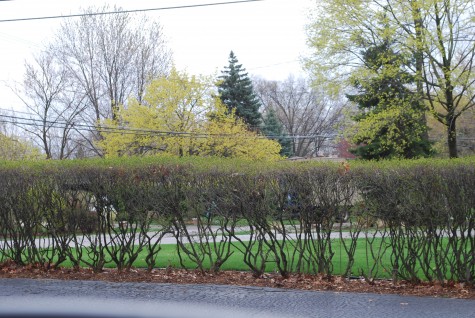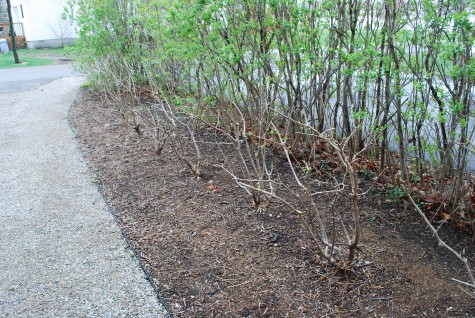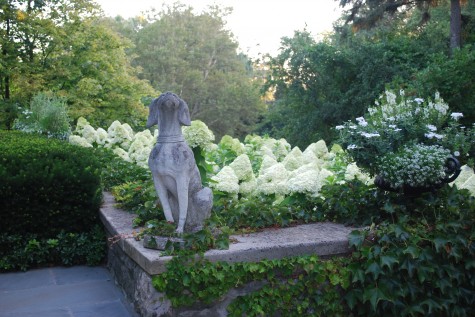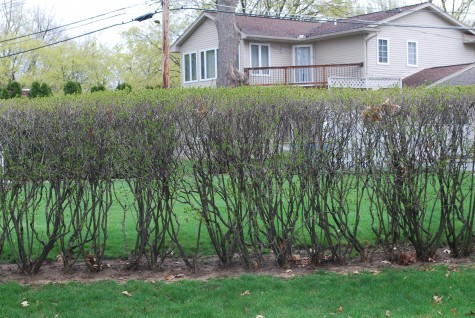 This hedge has everything going wrong. More than likely, it gets topped every year with an electric hedge clipper. The work goes fast, and the result makes me cringe. Repeated cuts into the top layer has resulted in so many branch breaks that the resulting dense top layer of foliage forms an impenatrable barrier to light to the interior of the shrub. This hedge is mostly sticks, all year round. Pruning branches individually takes a lot more time, but the time it takes is worth it. Sometimes I describe pruning as a haircut-specifically, a shag haircut. The branches on top are short and shaggy; the upper side branches are headed back slightly to allow light to get all the way to the bottom.
This hedge has everything going wrong. More than likely, it gets topped every year with an electric hedge clipper. The work goes fast, and the result makes me cringe. Repeated cuts into the top layer has resulted in so many branch breaks that the resulting dense top layer of foliage forms an impenatrable barrier to light to the interior of the shrub. This hedge is mostly sticks, all year round. Pruning branches individually takes a lot more time, but the time it takes is worth it. Sometimes I describe pruning as a haircut-specifically, a shag haircut. The branches on top are short and shaggy; the upper side branches are headed back slightly to allow light to get all the way to the bottom.
The early season look of this hedge is ample evidence that skirting up a shrub is a bad idea. In an effort to keep the sides of the shrub perfectly vertical, all those stray side branches have been pruned off. Not so clear from this picture is that the hedge had been planted so close to the driveway that any side branches would impinge on that hard surface. This hedge in its natural state would be 4 times as wide, and beautiful. A skirted shrub is all legs, with little tufts of green on the top. Naturally, carefully consider placement before you plant.
 This lilac hedge is wedged between two driveways. There really isn’t room between the drives for any plant that I know of, even though the screen is welcome to both neighboring parties. To make the best of a bad situation, regularly removing the largest stem to the ground every year will encourage the lilac to sprout from the ground level. This keeps the green coming from below. This hedge has a decidedly layered look. A lower layer of green, then a taller layer of sticks, then another layer of green. This striping is very evident in early spring. Its clear these lilaces were pruned across the top, all the same height, on repeated occasions. Pruning branches irregularly, at all different heights, encourages green all over. Only a few plants can be pruned into boxes and globes, or balloons. Balloon bushes are those skirted up stick shrubs with balls of green at the top; they look like a hot air balloon, only not as pretty. This is a particularly displeasing look, as it bears no remote resemblance to any plant’s real habit of growth.
This lilac hedge is wedged between two driveways. There really isn’t room between the drives for any plant that I know of, even though the screen is welcome to both neighboring parties. To make the best of a bad situation, regularly removing the largest stem to the ground every year will encourage the lilac to sprout from the ground level. This keeps the green coming from below. This hedge has a decidedly layered look. A lower layer of green, then a taller layer of sticks, then another layer of green. This striping is very evident in early spring. Its clear these lilaces were pruned across the top, all the same height, on repeated occasions. Pruning branches irregularly, at all different heights, encourages green all over. Only a few plants can be pruned into boxes and globes, or balloons. Balloon bushes are those skirted up stick shrubs with balls of green at the top; they look like a hot air balloon, only not as pretty. This is a particularly displeasing look, as it bears no remote resemblance to any plant’s real habit of growth.
These hydrangeas have been pruned back to a few main trunks. Though the look is sparse, there is little to fear. Limelights bloom on new wood. They do not bloom until July in my zone. There is plenty of time for this shrub to grow and put out flowers. Cutting back to these main trunks in the spring keeps the shrb in scale with the allocated space in a natural way. Letting pruning go for too long only makes your shrub renovation look even more extreme.
 Hydrangeas grow fast. This bleak look lasts for only a short time in the spring.
Hydrangeas grow fast. This bleak look lasts for only a short time in the spring.
I prune my own hydrangeas to a roughly symmetrical height, first. Mine are grown in blocks, not rows; they make a substantial mass when they bloom. They are also tucked behind a Hicks yew hedge; I need every inch of height I can get out of my hydrangeas so I can see their flowers from the street. Pruning should be done with a particular end result in mind. I do not prune my hydrangeas any lower than 30″ overall, as I like their height.
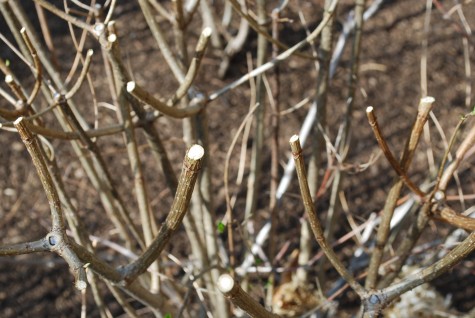 Once I have pruned down to the height I like, I then prune out crossing branches. I may prune out the center of the shrub if I think it has gotten too dense. I leave the outside branches alone. There might be some vague resemblance to an egg laid on its side, with holes in the top-when I am done pruning.
Once I have pruned down to the height I like, I then prune out crossing branches. I may prune out the center of the shrub if I think it has gotten too dense. I leave the outside branches alone. There might be some vague resemblance to an egg laid on its side, with holes in the top-when I am done pruning.
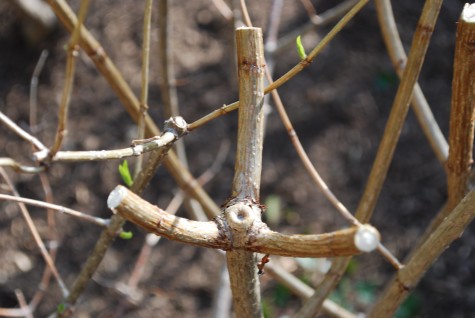 It is easy to see that this single old calloused cut from last spring resulted in three new branches. Pruning is not the end of something-it is the start of something bigger. These three branches from last year, located in the center of the shrub, I have pruned back hard. I like to avoid long runs of woody branches-as I do not like hydrangea plants that droop. A sturdily branched undercarriage makes for a strong and weather tolerant shrub.
It is easy to see that this single old calloused cut from last spring resulted in three new branches. Pruning is not the end of something-it is the start of something bigger. These three branches from last year, located in the center of the shrub, I have pruned back hard. I like to avoid long runs of woody branches-as I do not like hydrangea plants that droop. A sturdily branched undercarriage makes for a strong and weather tolerant shrub.
This bed of hydrangeas belongs to a client. They face down an old stone wall which is but four feet tall. She cuts them back very hard-to within 14 inches of the ground. She has in mind to keep the flowers at about the same height as the wall. Pruning hard keeps the eventual plant height in bounds.
